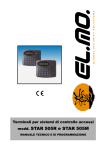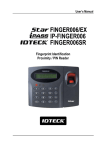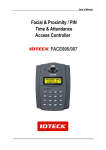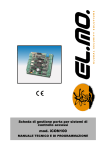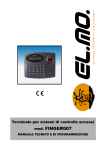Download OPERATING AND INSTALLATION MANUAL
Transcript
User’s Manual Proximity & PIN Time & Attendance Access Controller Table of Contents 1. Important Safety Instructions ........................................................................... 3 2. General................................................................................................................ 3 3. Features .............................................................................................................. 4 4. Specification....................................................................................................... 4 5. Identifying Supplied Parts................................................................................. 5 6. Product Overview .............................................................................................. 6 7. Installation Checkpoint & Tips.......................................................................... 9 8. Installation ........................................................................................................ 12 9. Communications.............................................................................................. 16 10. Basic Settings ................................................................................................ 19 11. Operations ...................................................................................................... 23 12. Setting Changes............................................................................................. 23 13. Appendix......................................................................................................... 45 14. FCC Registration Information....................................................................... 50 15. Warranty Policy and Limitation of Liability ................................................. 51 16. Template.......................................................................................................... 53 1. Important Safety Instructions When using Standalone / Network Proximity Access Controller, basic safety precautions should always be followed to reduce the risk of fire, electrical shock, and injury to persons. In addition, the following safety guides should also be followed: 1. Fully read and understand all instructions and follow them completely. 2. Follow all warnings and instructions marked on the product. 3. Do not use liquid or aerosol cleaners. Use a damp cloth for cleaning. If necessary, use mild soap. 4. Do not use this product near water. 5. Only operate this product using the type of power source indicated. If you are not sure of the type of power supplied to your installation site, consult your dealer of local power company. 6. Never insert objects of any kind into the product or through the cabinet slots as they may touch voltage points and/or short circuit parts possibly resulting in fire or electric shock. Never spill liquid of any kind on the product. 7. Never disassemble this product by yourself; take the unit to a qualified service center whenever service or repair is required. Opening or removing the covers may expose you to dangerous voltages or other risks. Also, incorrect reassembly can cause electric shock when the unit is subsequently used. 8. Unplug this product from the Direct Current (DC) power source and refer to qualified service personnel under these conditions: a. When the power supply cord or plug is damaged or frayed. b. If liquid has been spilled on the product. c. If the product does not operate normally after following the operating instructions in this manual. Adjust only those controls that are covered by the operating instructions in this manual. Improper adjustment of other controls that are not covered by this manual may damage the unit and will often require extensive work by a qualified technician to restore normal operation. d. If the product exhibits a distinct change in performance. 2. General The Star 505R is a highly advanced, intelligent single door controller with a dual 8bit microprocessor to meet the market requirement for a robust integrated solution for access control and time & attendance. It is designed for low cost as well as high security, convenience and reliability. This user-friendly device allows you to register 500 ~ 10,000 ID numbers and can keep 2,500 ~ 7,250 events. Number of ID & Events can be exchanged under the ratio of 2 to1, which means every 500 users can be converted to 250 events. The Event buffer reports and archive information to Excel or Access databases and ultimately manage all access control and time & attendance issues. With a built-in 4” inch RF reader and keypad for Personal Identification Numbers (PIN), the STAR505R offers up to two levels of ID verification. You can verify by Proximity Card, PIN or both and multiple verification levels can be custom programmed for each user or user group. Four independent input ports can be utilized for a wide variety of controls including exit buttons, door contacts, PIR sensors and fire detection equipment. Actions to be taken and time settings can be programmed with the front keypad or via the intuitive Windows-based software program. The Star 505R can be used both as a stand-alone system and also be networked. All control setting values such as ID numbers, inputs/outputs, real-time clock, time schedules, and event transaction reports can be uploaded and/or downloaded to and from the host computer. The compact and contemporary unit is easily installed and programming requires no 3 significant knowledge of access control or time & attendance. The three LED indicator lights inform you of the systems operating status at real time and the digital display acts as a programming aid as well as a regulation time clock. By bundling the ultimate in high security access control and comprehensive employee management tools into a compact user friendly unit, the field proven Star 505R is the ideal solution for controlling entrances and ensuring complete employee accountability. 3. Features - 125 KHz Standalone Proximity / PIN Access Controller - Dual Function for Access Control and Time & Attendance - Dynamic Control of Memory up to 10,000 Users / 7,250 Event Buffers - Standalone / Network Communication via RS232 / RS422 / RS485 (Max.32ch), TCP/IP (External LAN Converter Required) - 1ea of External Reader Port for Anti-Pass-Back: 26bit Wiegand and 4 / 8bit Burst for PIN - Duress Mode Function - Independent 4 Inputs and 4 Outputs Including 2 Form-C Relay Outputs - Dual Tamper Switches - Alarm Event Monitoring using Tamper Switch (by Application Software) - Compatible Software: STARWATCH DUAL PRO I / II * Comparison Table Built-in 125KHz (4”) Proximity Reader RF Only / PIN(4~6digit) Only / RF + P/W(4digit) ASK[EM] Format Built-in 125KHz (4”) Proximity Reader RF Only / PIN(4~6digit) Only / RF + P/W(4digit) Built-in 13.56MHz (4”) Proximity Reader ISO14443 Type A Compatible Serial Number Read Only 505R IP505R SR505 4. Specification Model 505R Dual 8bit Microprocessor CPU Memory Program Memory Data Memory User Event Buffer Read Range Passive Type Active Type Reading Time (Card) 64KByte ROM 128KByte SRAM (Battery back up) 500 ~ 10,000 Users 2,500 ~ 7,250 Event Buffers IDK50 / IMC125: Up to 2 inch (5cm) IDC80 / IDC170: Up to 4 inch (10cm) IDA150 / IDA200 Compatible 30ms 4 Power / Current External 505R / Reader IP505R Port SR505 Communication Baud Rate Input Port Output Port LCD Keypad LED Indicator Beeper LCD Controller RF Reader Operating Humidity Color / Material Dimension (W x H x T) Weight Certification Operating Temperature DC 12V / Max.350mA 1ea (26bit Wiegand, 4/8bit Burst for PIN) 1ea (34bit Wiegand, 4/8bit Burst for PIN) RS232 / RS422 / RS485 (Max.32ch) TCP/IP (External LAN Converter Required) 9600bps (Default) / 4800bps, 19200bps and 38400bps (Selectable) 4ea (Exit Button, Door Sensor, Aux#1, Aux#2) 2ea (FORM-C Relay Output (COM, NO, NC) / DC12V~18V, Rating Max.2A) 2ea (TTL Output / DC5V, Rating Max.20mA) Character LCD ( 2 Lines x 16 Char) / 2.62” x 0.55”(65.6mm x 13.8mm) Screen 16 Key Numeric Keypad with Back Lighting 4 Array LED Indicators (Red, Green and Yellow) Piezo Buzzer 0° to +50°C (+32° to +122°F) 0° to +70°C (+32° to +158°F) -35° to +65°C (-31° to +149°F) 10% to 90% relative humidity non-condensing Dark Pearl Gray / Polycarbonate 150mm x 120mm x 39.5mm (5.9” x 4.72” x 1.55”) 397g (0.88lbs) UL, FCC, CE, MIC 5. Identifying Supplied Parts Please unpack and check the contents of the box. (Optional accessories, if purchased, may be included in the package) Main Unit ( 1ea ) Wall Mount ( 1ea ) O-ring ( 5ea ) 5 User’s Manual ( 1 copy ) Diode ( 2ea ) 6. Product Overview 6.1 Functions Stand-Alone Operation The Star 505R is capable of having 2 readers (1 Door Control). The unit receives card ID numbers from the proximity readers and determines whether or not to unlock the door. When an input signal is entered, for example from a Sensor activated or an Exit button pressed, the controller generates and logs an appropriate response by input signals. All events are stored into the memory buffers and sent to the host computer. The access controller is a true standalone device that, in the event of malfunction, will not affect other units when used in conjunction with one another.Operation with Host Computer All event transactions can be managed via the host computer. The data transmitted from the controller can be displayed and stored on the host PC. Data Backup The controller retains all user information and event data for 30 days, even in the case of power failure. ※ CAUTION: Battery switch must be set correctly before the unit running. (See the INSTALLATION section) Keypad If the Star 505R is not connected to a host PC, the integrated keypad and LCD display module can also be used for the entire programming process. Anti-Pass-Back By using an additional proximity reader, the Anti-Pass-Back mode can be set. The Anti-passback mode prevents entry or exit when the registered user did not properly followed one entry and one exit by the Anti-pass-back rule. The same user can not enter twice with the entry card without properly using the exit before. Input/Output The Star 505R has 4 built-in inputs and 4 outputs (2 relay outputs and 2 TTL outputs) which can be used to manipulate a wide variety of controls. Time Schedule Setup You can program 10 time schedules and apply one time schedule to each User. Each time schedule has 8 different time zones from Monday-Sunday (7 time zones) and one holiday. Each time zone has 5 different time codes so you can program 5 different time codes to each day. You can also program time schedules for individual inputs and outputs. Note that the time schedule for input is activated time code for input device so that the input is activated during the time code on this time schedule. Each time schedule is linked to one holiday schedule and this linked holiday only validates to the holiday time code of the time schedule. Holiday Schedule Setup Excepting Sunday, you can program 32 holidays to one holiday schedule. Each holiday schedule is linked to one time schedule which has a time code for holidays. You can program all holidays to a holiday schedule and the time code for holidays is programmed to the holiday time zone of time schedule. Example: A. Holiday schedule 01 linked to time schedule 01, Holiday schedule 02 linked to time schedule 02 B. Holiday schedule 02 linked to time schedule 01, Holiday schedule 01 linked to time schedule 03 Forced Door Open Alarm When the door is opened by force, the door contact sensor will be activated. The forced door open alarm will be generated until the door is closed again. For this application, you have to 6 install the door contact sensor and properly set the door contact time and outputs to the alarm devices. Duress Alarm In case of duress, enter the 2 digits Duress Password and press the<ENT> key before the normal access process. The door can be opened as normal, but the duress alarm is also generated at the same time. The duress alarm output will be activated to the TTL output and an alarm event will be sent to the host PC. 6.2 Product Explanation 6.2.1 Front Panel Description LCD Display Card Reading Status LED System Operation Status LED 10 Numeric Keypad Function Keypad Figure: Description of Star 505R Front Panel Figure: Description of Star 505R Back Panel LCD Module: LCD module display 505R status. System Operation Status LED: When the power is applied to 505R, the red LED is turned on. When the Relay #1 is operated, the green LED is turned on. When the Relay #2 is operated, the yellow LED is turned on. 16 key pad: You can operate Star 505R manually by using the key pad. 7 Function key: The Star 505R has four Function keys ([F1], [F2], [F3], [F4]). Card reading status LED: When a card is read, the card reading status LED turns on green. Backup Battery DIP Switch: Star 505R has a switch for the backup battery connection, which remains open circuit to prevent any current consumption of the backup battery. 6.2.2 WIRE COLOR TABLE OF THE Star 505R SIGNAL COLOR Main Power (+12V) Power Ground (GND) Door Relay Out (COM) Door Relay Out (NC) Door Relay Out (NO) Alarm Relay Out (COM) Alarm Relay Out (NC) Alarm Relay Out (NO) TTL Out 1 TTL Out 2 Exit Button In Door Contact In Aux In 1 Aux In 2 Wiegand Data 0 In Wiegand Data 1 In RS232 (TX) RS232 (RX) RS422 (TX+) RS422 (TX-) RS422 (RX+) RS422 (RX-) Red Black Gray with Red stripe Blue with White stripe White with Red stripe White Purple with White stripe Purple Orange with White stripe Brown with White stripe Orange Yellow with Red stripe Green Green with White stripe Pink Cyan Black with White stripe Red with White stripe Gray Yellow Brown Blue * Please cut out tail connector before installation. 8 7. Installation Checkpoint & Tips Installing the Star 505R is an easy task. It can be installed with common hand tools and readily available communications wires. This section provides information about wiring, wire runs and other information to make the installation quick and easy. 7.1 CHECK POINTS BEFORE INSTALLATION 7.1.1 SELECTION OF CABLE System installation cabling will be configured as follow. Figure: System Installation Layout 7.1.2 RECOMMENDED CABLE TYPE AND PERMISSIBLE LENGTH OF CABLE Reference Description Cable Specification Maximum Distance ① 505R Power (DC12V) DC Power -> 505R Belden #9409, 18 AWG 2 conductor, unshielded 30m ②* Reader (Power and Data) Extra Reader -> 505R Belden #9512, 22 AWG 4 conductor, shielded Belden #9514, 22 AWG 8 conductor, shielded 150m ③ Door Contact Belden #9512, 22 AWG 9 300m ④ ⑤ ⑥ *: 4 conductor, shielded Exit Button Sensor Input Input -> 505R Door Lock, Alarm Device Lock (Alarm) -> 505R RS232 Cable Converter -> Host P.C. RS485 Cable 505R -> 505R 505R -> Converter RS422 Cable 505R -> 505R 505R -> Converter Belden #9514, 22 AWG 8 conductor, shielded Belden #9409, 18AWG 2 conductor, unshielded Belden #9829, 24 AWG 2-twisted pair, shielded Belden #9829, 24 AWG 2-twisted pair, shielded 300m 15m 1,200m Belden #9830, 24 AWG 3-twisted pair, shielded Need thicker wire if you connect the reader with high current consumption. 7.2 CHECK POINT DURING INSTALLATION 7.2.1 TERMINATION RESISTOR Termination resistors are used to match impedance of the network to the impedance of the transmission line being used. When impedance is mismatched, the transmitted signal is not completely absorbed by the receiver and a portion of signal is reflected back into the transmission line. The decision whether or not to use termination resistors should be based on the cable length and data rate used by the communication system. For example, if you use 9,600 baud rate and 1,200m length of cable, the propagation velocity of cable is 0.66 x speed of light (This value is specified by the cable manufacturer), if we assume the reflections will damp out in three round trip up and down the cable length, the transmitted signal will stabilize 18.6us after the leading edge of a bit. Since the data bit is captured in the middle of the bit which is approximately 52us after the leading edge of a bit. The reflection stabilizing time 18.6us is much before the center of the bit therefore the termination resistors are not required. However, if you install the cable to maximum length, the impedance of cable and network is mismatched and the transmitted signal is overlapped by the reflected signal. In this case, it is recommended to add termination resistors to the end of the receiver lines. A 120Ω resistor can be used for termination resistor in parallel between the receiver lines “A” and “B” for 2 wires RS485 system or “RX+” and “RX-” for 4 wires RS422 system. A termination resistor of less than 90Ω should not be used and no more than 2 terminations should be used in one networking system. 7.2.2 HOW TO CONNECT TERMINATION RESISTORS Figure: Termination resistors for 2 wire RS485 communication system 10 Figure: Termination resistors for 4 wire RS422 communication system 7.2.3 GROUNDING SYSTEM FOR COMMUNICATION CABLE We recommend to using proper grounding system on the communication cable. The best method for grounding system is to put the shield wire of the communication cable to the 1st class earth grounding; however it is not so easy to bring the earth ground to the communication cable and also the installation cost is raised. There will be three grounding point where you can find during installation; 1) Earth Ground 2) Chassis Ground 3) Power Ground The most important point for grounding system is not to connect both ends of shield wires to the grounding system; in this case there will be a current flow through the shield wire when the voltage level of both ends of shield wire is not equal and this current flow will create noise and interfere to communications. For the good grounding, we recommend to connecting ONLY one end of shield wire of communication cable to grounding system; If you find earth ground nearby, then connect one end of shield wire to earth ground; If you do not have earth ground nearby, then find chassis ground and connect one end of shield wire to chassis ground; If you do not find both earth ground and chassis ground, then connect one end of shield wire to power ground. (GND of Star 505R) Note that if the chassis ground is not properly connected to the earth and floated from the ground level, then grounding to the chassis ground will give the worst communication; in this case we recommend to using power ground instead of chassis ground. Figure: Grounding system 11 7.2.4 REVERSE DIODE CONNECTION If you connect an inductor (Door Locks or Alarm device) to the output relays, there will be a high surge voltage created while the inductor is turning on and off. If you do not connect reverse diode, the surge voltage will transfer and damage to the electronic circuit of the controller. It is strongly recommended to add a reverse diode between the inductor coils to absorb this surge voltage. Figure: Reverse Diode connection 8. Installation 8.1 DIMENSIONS Unit: mm(inch) 150mm (5.9 ”) x 120mm (4.72 ”) x 39.5mm (1.55 ”) 8.2 BACKUP BATTERY DIP SWITCH Star 505R has a switch for the backup battery connection, which remains open circuit to prevent any current consumption of the backup battery (Figure: Switch setting). Before the Star 505R operation, it needs to be connected so that the backup battery can retain the memory during power failure. Figure: DIP SWITCH SETTING Figure: DIP SWITCH LOCATION 12 8.3 SYSTEM INITIALIZATION Connect the cyan wire, pink wire and black wire (they are seen from the rear view) together and power on the unit. If you want hardware initialization, press enter key <1>. After initializing – switch main power OFF, separate the three wires (pink, cyan and black(GND)) and switch the main power ON again. Power on If you turn on the system power after connected 3 wires (pink, cyan and black(GND)), you can enter into system initialize mode. Initialize OK? 0: NO 1: Yes <1> key enter? NO Yes Normal Operation "Initialize Com." "Turn OFF Power..." Power off Disconnect 3 wires ( pink, cyan, black) . System initialization completion 8.4 INSTALLATION OF THE PRODUCT 8.4.1. Tear off page 56 and use the provided template to drill two 6-32 holes and one 1/2" hole on the proper location of the wall to mount the Wall Mount bracket as shown below. (Skip this step if the gang box is already installed on the wall.) 13 8.4.2 Using 2 screws, install wall mount to the wall. ※ CAUTION Before mounting the STAR 505R unit to the Wall Mount bracket, operational test of the unit should be completed, as the locking pins will lock the unit to the Wall Mount. Removing the unit from the Wall Mount bracket after they have been installed together may cause damages to the bracket and render its effectiveness. 8.4.3 Insert 5 O-rings to the wall mount as indicated, then route the cable of the main unit through the center hole and push the main unit to wall mount to lock the main unit and make sure that the main unit is locked with wall mount. 8.5 WIRING 8.5.1 POWER Connect (+) wire of DC 12V power to the Red wire. Connect GND (-) wire of DC 12V power to the Black wire. 8.5.2 INPUT CONNECTIONS Exit Button Connection - Connect one wire from an Exit Button to the Orange wire. - Connect the other wire from the Exit Button to the GND. Door Contact Sensor Connection - Connect one wire from a Door Contact Sensor to the Yellow wire with Red stripe. - Connect the other wire from the Door Contact Sensor to GND. Auxiliary Input Connection (Applied to Aux Input #1(Green wire), Aux Input #2(Green wire with White stripe)) - Connect one wire from an Auxiliary Input Device to one of the Input #1, #2. - Connect the other wire from the Auxiliary Input Device to GND. Figure: INPUT DEVICES CONNECTION 8.5.3 OUTPUT CONNECTIONS Door Lock (Power Fail Safe) Connection (Relay #1) - Connect COM wire of Relay #1, the Gray wire with Red stripe to +12V. - Connect NC wire of Relay #1, the Blue wire with White stripe to (+) wire of door lock device. - Connect GND wire to (-) wire of door lock devices. 14 Door Lock (Power Fail Secure) Connection (Relay #1) - Connect COM wire of Relay #1, the Gray wire with Red stripe to +12V. - Connect NO wire of Relay #1, the White wire with Red stripe to (+) wire of door lock device. - Connect GND wire to (-) wire of door lock devices. Alarm Device Connection (Relay #2) 1. Connect COM wire of Relay #2, the White wire to +12V. 2. Connect NO wire of Relay #2, the Purple wire to (+) wire of Alarm devices. 3. Connect GND port to (-) wire of Alarm devices. Figure: DOOR LOCK, ALARM DEVICE CONNECTION CAUTION: Please add one DIODE as shown above. DIODE: Fast recovery DIODE (current: Min. 1A), 1N4001 ~ 1N4007 or similar. 8.5.4 EXTRA READER CONNECTIONS Proximity Reader Connection 1. Connect (+) wire of the Proximity Reader to DC +12V. 2. Connect (-) wire of the Proximity Reader to GND of Power. 3. Connect Data-0 wire of the Proximity Reader to D0, the Pink wire. 4. Connect Data-1 wire of the Proximity Reader to D1, the Cyan wire. Compatible Readers: 505R/iP-505R: Standard 26bit Wiegand Format Proximity Readers. Standard 26bit Wiegand+8bit Burst Format Proximity and Keypad Readers. SR505: Standard 34bitWiegand Format Proximity Readers. Standard 34bitWiegand+8bit Burst Format Proximity and Keypad Readers. Recommended Readers: 505R: RF-TINY, RF10, RF20, RF30, RFK101, FGR006, FGR006EX. iP-505R: iP10, iP20, iP30, iPK101. SR505: SR10, SR20, SR30, SRK101, FGR006SR, FGR006SRB. 15 9. Communications 9.1 RS232 COMMUNICATION PORT CONNECTION A 9-pin connector (Serial communication connector, female) is required to connect the 505R to a host computer via RS232 communication. Please follow the instructions. 1. Connect RS232-TX (Black wire with White stripe) wire of 505R to the pin #2(RX) of the 9-pin connector. 2. Connect RS232-RX (Red wire with White stripe) port of 505R to the pin #3(TX) of the 9-pin connector. 3. Connect GND (Black wire) of 505R to the pin #5 of the 9-pin connector. 4. Plug in the 9-pin connector to COM1 or COM2 Port of the host PC. 5. Install and run 505R Application Software. Figure: RS232 COMMUNICATON 9.2 RS-422 COMMUNICATION PORT CONNECTION 9.2.1 RS-422 CONNECTION (STAND ALONE) RS422/RS232 converter (CNP200) is required to use RS422 communication between the 505R and a host computer. Please follow the instructions. 1. Connect RS422-TX(-)(Yellow wire) of the 505R to RS422-RX(-) port of the converter. 2. Connect RS422-TX(+)(Grey wire) of the 505R to RS422-RX(+) port of the converter. 3. Connect RS422-RX(-)(Blue wire) of the 505R to RS422-TX(-) port of the converter. 4. Connect RS422-RX(+)(Brown wire) of the 505R to RS422-TX(+) port of the converter. 5. Plug the RS232 9-pin connector of the converter into the COM1 or COM2 Port of the PC. 6. Install and run the 505R Application Software. 16 To Star 505R To host PC a) Between 505R and CNP200 b) RS 422 port connection c) CNP200 setting Figure: RS-422 Communication between 505R and Host Computer 9.2.2 RS-422 CONNECTION (MULTIPLE 505R CONNECTIONS) RS422/RS232 converter is required to use RS422 communication between multiple 505R and a host computer. Please follow the following instructions. First, you have to connect all RS422 port of all 505Rs in parallel. 1. Connect RS422-TX(-)(Yellow wire) of one 505R to RS422-TX(-)(Yellow wire) of another 505R. 2. Connect RS422-TX(+)(Grey wire) of one 505R to RS422-TX(+)(Grey wire) of another 505R. 3. Connect RS422-RX(-)(Blue wire) of one 505R to RS422-RX(-)(Blue wire) of another 505R. 4. Connect RS422-RX(+)(Brown wire) of one 505R to RS422-RX(+)(Brown wire) of another 505R. Second, you have to connect one of RS422 port of 505R to RS422/RS232 converter. 1. Connect RS422-TX(-)(Yellow wire) of the one 505R to RX(-) port of the converter. 2. Connect RS422-TX(+)(Grey wire) of the one 505R to RX(+) port of the converter. 3. Connect RS422-RX(-)(Blue wire) of the one 505R to TX(-) port of the converter. 4. Connect RS422-RX(+)(Brown wire) of the one 505R to TX(+) port of the converter. 17 5. Plug the RS232 9-pin connector of the converter into the COM1 or COM2 Port of the PC. 6. Install and run the 505R Application Software. Figure: RS-422 Communication between 505Rs and Host Computer 9.3 DIAL UP MODEM - Please read the Software manual. 9.4 TCP/IP CONVERTER (EXTERNAL VERSION) - Please read the Software manual. 18 10. Basic Settings 10.1 INITIALIZATION OF 505R Connect the cyan, pink and black wires (they are seen from the rear view) together and Power on the unit. If you want hardware initializing, press Enter key <1>. After initializing – Put the main power OFF and separate 3 wires (Pink, cyan and black(GND) ). Afterwards put main power ON again. Power on If you turn on the system power after connected 3 wires (pink, cyan and black(GND)), you can enter into system initialize mode. Initialize OK? 0: NO 1: Yes <1> key enter? NO Yes Normal Operation "Initialize Com." "Turn OFF Power..." Power off Disconnect 3 wires ( pink, cyan, black) . System initialization completion 10.2 HOW TO ENTER THE SET-UP MENU To set up or to change the 505R settings, you have to enter the SETUP MENU first. To do so, press the <0> key eight times for the Master ID (Default setting “00000000”) and the <ENT> key from the Keypad. Then you can get into SETUP MENU. There are four main SETUP MENUS and you first get into [SETUP MENU F1]. You can move to another SETUP MENU by pressing the<F1> key for [SETUP MENU F1], <F2> key for [SETUP MENU F2], <F3> key for [SETUP MENU F3] and <F4> key for [SETUP MENU F4]. There are several SUBMENUS in the main SETUP MENU and you can scroll up and down the SUBMENU by pressing <4> and <6> key in the main SETUP MENU. If you don’t press any key for 60 seconds or if you press the <ESC> key, 505R will exit the SETUP MENU and return to normal operation. You can also change the Master ID in the [SETUP MENU F1]. 19 In the case of SR505, Press ten times the <0> key (Default setting “0000000000”) to enter the SETUP MENU. 10.3 DATE AND TIME SETTING Select [TIME SETTING] in the [SETUP MENU F1] and enter the Year / Month / Date / Hour / Minute / Second / Day (Total 15 digits) as shown below. The LCD will display the new Date and Time after the time setting completed but the year and day will not be displayed. 505R has a 24 hours system and day codes are 1 for Sunday, 2 for Monday, 3 for Tuesday, 4 for Wednesday, 5 for Thursday, 6 for Friday and 7 for Saturday. The Master ID for SR505 is a ten digit number (Default setting “0000000000”). STAR 505R [F1] 01/01 “MASTER ID” + <ENT> Press <F1> Select [TIME SETTING] 00:00:15 + <ENT> 8 times <0> + <ENT> Initial Display TIME SETTING YYYYMMDDhhmmssW 200301200900005 <ENT> > <ENT> “Year/Month/Day/Hour/Min./Sec./Day” TIME SETTING STAR 505R [F1] <ESC> 01/20 09:00:00 > LCD displays after time setting 10.4 ID COUNT SETTING 505R can register maximum 10,000 User IDs and you can select maximum User IDs to be registered into the 505R from 500 Users up to 10,000 Users by every 500 unit. This ID COUNT setting is to configure maximum User ID to be registered into 505R and if you setup less ID COUNT 505R will increase the EVENT Buffer size to maximum. The default ID COUNT is 5,000 Users and the default EVENT Buffer size is 5,000. It can be stored when you operate 505R off-line. Select [ID COUNT] in the [SETUP MENU F3], then setup the maximum User IDs to be registered into 505R. Follow the steps to setup the ID COUNT. The Master ID for SR505 is a ten digit number (Default setting “0000000000”). STAR 505R [F1] “MASTER ID” + <ENT> Press <F3> + <4> or <6> 01/20 09:00:33 Initial Display ID COUNT 5,000 8 times <0> + <ENT> Select [ID COUNT] ENTER ID COUNT [10000] <ENT> > Enter the number from 500 to 10000 ID COUNT 10,000 <ESC> > 20 STAR 505R [F1] 01/20 09:01:16 <ENT> > EVENT MEMORY NOT EMPTY!!! ID TOTAL COUNT Wrong!!! ☞ You will see this error message when you press <ENT> key in the [ID COUNT] menu. It tells you that some events are still existing in the EVENT Buffer and you may lose the data if you change the ID COUNT. You may try this setting again after uploading the events to the host PC or deleting them, using the [SETUP MENU F1] - [EVENT CLEAR]. ☞ You will see this error message if you try to change ID COUNT less than the total registered User IDs. In this case you have to delete some User IDs or clear them all, using the [SETUP MENU F1] -> [ID CLEAR] first, then try again from the beginning. 10.5 ID REGISTRATION You can register the User ID into the 505R. Select [SETUP MENU F3] -> [ID REGISTRATION] and follow the steps below. For 505R or IP505R, registration can be done either with RF cards or via keypad input, depending on the Reader 1 Mode setting. The Master ID for SR505 is a ten digit number (Default setting “0000000000”). “MASTER ID” + <ENT> STAR 505R [F1] 01/20 09:01:23 8 times <0> + <ENT> Press <F3> then Select [ID REGISTRATION] Initial LCD Display ID REGISTRATION ‘ENT’ ID REGISTRATION 1:Card 2:Key This step appears only on SR505 1. Registration by RF Cards (Applicable if 1:Card is selected on SR505 or if Reader 1 Mode on 505R or IP505R is RF Only or RF+PW.) ‘1’ Scanning … Approach card Reader1 Password (4 digits) + <ENT> Time Schedule codes + <ENT> Reader Usage codes + <ENT> 123456 PW____ TS__ RD_ ID Registered Reg. completed 21 2. Registration by Keypad (Applicable if 2:Key is selected on SR505 or if Reader 1 Mode on 505R or IP505R is PIN Only.) ‘2’ [________] PW____ TS__ RD_ ID(6digits) + <ENT> 123456 PW____ TS__ RD_ No PW field on 505R or IP505R Password (4digits) + <ENT> Time Schedule codes + <ENT> Reader Usage codes + <ENT> ID Registered Reg. completed! 1. Scanning: The reader is waiting for an RF card which has to be registered. The card number will appear with a beep as the card is read. ID number is a 6 digit number. (ID number of SR505 is a ten digit number.) 2. ID [________]: ID number consists of 4 - 6 digits ID numbers. Enter 4 - 6 digits ID numbers and press <ENT> key in the ID[________] field. When the Reader mode is PIN, it is displayed on the LCD. (NOTE: An ID number of the SR505 is a 10-digit number.) 3. PW [____]: PW is the password which can be used to access the doors where you install a Proximity and Keypad Reader and setup the RF + Password operating mode. But regardless of the operating mode, it is necessary to enter a default password (0000) in the PW [____] field when you register an ID. NOTE: For 505R or IP505R, this field does not appear during registration via the keypad. 4. TS: TS is the Time Schedule code (00-10). TS is the Time Schedule for the Reader #1, Reader #2. When you present the card to a Reader, the cardholder is only allowed the access of the door during the Time Schedule code entered to TS__. To control the accessible Time Schedule for each cardholder, you must setup the Time schedules first and enter the Time Schedule code here. If you want to access the door anytime for the cardholder then enter default Time Schedule code '00' for the value. 5. RD__: RD is the Reader Usage code for the cardholder. If you put in ‘1’ for RD, Reader #1 is accessible and if you put ‘0’ for RD, the cardholder can not access through the Reader #1(Reader #2). 505R generates an error message (“Access Door Error”) and displays it on the LCD. To get access through all Readers, you have to put in ‘3’ as a value for RD. 22 11. Operations 11.1 NORMAL OPERATION Power on When the power is applied to 505R, the Red LED is turned on. Registered card reading When a registered card (or PIN) is read, the Door (Relay #1) will open for 3 seconds (Default) with the Green LED on. Exit Button To request an exit from the inside, an Exit Button (or an Exit Reader) can be used. The Door (Relay #1) will open for 3 seconds with the Green LED on. Alarms When an unregistered card is read, the access is denied and the alarm (Relay #2) will be activated for 3 seconds with the Yellow LED on. 11.2 DEFAULT SETTING When you operate the 505R for the first time or want to initialize the 505R, the controller will setup all value defaults (factory settings). You can change the settings for the desired application. Please refer to the APPENDIX for the default setting values. 12. Setting Changes INITIAL DISPLAY (MODEL NAME, CURRENT TIME) NO ID INPUT ? YES NO MASTER ID ? OPERATE GENERAL MODE YES SETUP MODE SETUP F1 MODE 1. READER 1 MODE 2. READER 2 MODE 3. TIME SETTTING 4. APB SETUP 5. COMM ADDRESS 6. BAUD RATE 7. EVENT CLEAR 8. MASTER ID CHANGE 9. SYSTEM INITIALIZE 10. CARD ID CLEAR 11. TIME SCHE CLEAR 12. RF_PIN_INPUT 13. EVENT MEMORY 14. DURESS MODE SET 15. FUNCTION KEY 16. DATA BYTE TYPE SETUP F3 MODE SETUP F2 MODE 1. ID REGISTRATION 2. ID DELETE 3. ID LIST 4. REG. ID COUNT 5. ID COUNT 1. TIME SCHEDULE 2. HOLIDAY SETTING 3. IN/OUT DEFINE 4. HOLIDAY INDEX 5. MODE INDEX 6. LCD DISPLAY 7. OUTPUT TIME SET 23 SETUP F4 MODE 1. VERSION 2. SRAM TEST 3. OUTPUT TEST 4. LCD TEST 5. KEYPAD TEST 6. READER TEST 7. INPUT TEST 8. COMM TEST ☞. To setup or to change the 505R settings, you have to enter the SETUP MENU first. To do so, press the <0> key eight times for Master ID (Default setting “00000000”) and <ENT> key from the Keypad. Now you can get into SETUP MENU. There are 4 main SETUP MENUS and you first get into [SETUP MENU F1]. You can move to other SETUP MENUS by pressing <F1> key for [SETUP MENU F1], <F2> key for [SETUP MENU F2], <F3> key for [SETUP MENU F3] and <F4> key for [SETUP MENU F4]. There are several SUB MENUS in the main SETUP MENU. You can scroll up and down the SUB MENU by pressing the <4> and <6> key in the main SETUP MENU. If you don’t press any key for 60 seconds or if you press <ESC> key, 505R will exit the SETUP MENU and return to normal operation. In the case of SR505, Press ten times the <0> key (Default setting “0000000000”) to enter the SETUP MENU. 12.1 SETUP MENU F1 READER 1 MODE RF Only (DEFAULT) RF+P/W( PassWord ) key<4> or <6> PIN (4~6 Digit) READER 2 MODE RF Only (DEFAULT) RF+P/W( PassWord ) key<4> or <6> PIN (4~6 Digit) TIME SETTING 15 digit key in key<4> or <6> SEARCHING KEY <4> or <6> NOT USE (DEFAULT) APB SETUP USE key<4> or <6> ALL CLEAR COMM ID key<4> or <6> BAUD RATE 4800 9600 (DEFAULT) 19200 key<4> or <6> 38400 YES EVENT CLEAR NO key<4> or <6> CARD MASTER ID CHANGE 24 KEY key<4> or <6> SYSTEM INITIALIZE YES NO key<4> or <6> YES CARD ID CLEAR NO key<4> or <6> TIME SCHE CLEAR YES NO key<4> or <6> RF_PIN_INPUT SEARCHING KEY <4> or <6> ENABLE DISABLE (DEFAULT) key<4> or <6> EVENT MEMORY NOT USE key<4> or <6> USE (DEFAULT) DURESS MODE SET NOT USE (DEFAULT) USE key<4> or <6> DURESS P/W SETTING FUNCTION KEY NOT USE(DEFAULT) key<4> or <6> USE DATA BYTE TYPE 2BYTE 4BYTE(DEFAULT) 25 12.1.1 READER 1 MODE SETTING READER 1 MODE <ENT> RF Only (default) key<4> or <6> RF+PASSWORD key<4> or <6> PIN (4~6 Digit) READER 1 MODE RF ONLY ☞. READER 1 MODE is set to RF ONLY operating mode. If you want to change the mode to RF+PASSWORD operating mode, press <ENT> key. READER 1 MODE -> RF ONLY ☞. Now you can change the mode by pressing the <4> or <6> key to toggle the mode. If you want to setup the mode displayed, press <ENT> key to accept this mode. Note: RF ONLY: The door is accessible with the proximity card alone. RF+PW: The door is accessible with the proximity card and Password. PIN ONLY: The door is accessible with the PIN number (4-6 digits). If you select PIN, it will be affected to Reader 1 and 2. READER 1 MODE -> RF+PW READER 1 MODE -> PIN ONLY * READER 2 MODE setup is the same as above. * The SR505 doesn’t have READER 2 MODE. It is used RF + PASSWORD mode only Reader #1. 12.1.2 TIME SETTING TIME SETTING YYYYMMDDhhmmssW __________ ☞. Press <ENT> key and enter 15 digit Date/Time codes then <ENT> key to finish setting. YYYY: Year, MM: Month, DD: Date hh: Hours (24 hours system), mm: Minutes, ss: Seconds W: Sun=1, Mon=2, Tue=3, Wed=4, Thu=5, Fri=6, Sat=7 Example: 200302101330152 => Feb.10, 2003 13:30:15, Mon 12.1.3 ANTI-PASS-BACK MODE SETTING APB SETUP NOT USE ☞. It shows anti-pass-back operation is not in use. Press <ENT> key. (It only 26 applies when the door has an Exit Reader) APB SETUP -> USE ☞. Press <4> or <6> key for searching the APB mode. Press <ENT> key to select the mode. NOT USE: Anti-pass-back mode is not applied. USE: Anti-pass-back mode is separately applied. APB SETUP ->All Clear ☞. If you select All Clear, 505R will clear all APB flags and all users are not allowed Exit first. 12.1.4 COMMUNICATION ID(ADDRESS) SETTING ] COMM ID SETTING ☞. This is the Communication ID setting menu. To change the ID, press <ENT> key. COMM ID SETTING 00 ☞. The number on the LCD is the current communication ID(Device No.). Press <ENT> key again to set a new communication ID. COMM ID SETTING 01 ☞. When the cursor is blinking, enter a new ID (two-digit number), then the setting is completed. For the next setting, use <4> and <6> keys. Possible ID is between 00 - 31 inclusive. 12.1.5 BAUD RATE SETTING BAUD RATE 9600 BAUD RATE ->9600 BAUD RATE ->19200 ☞. iCON100 supports 4800, 9600, 19200 and 38400bps of baud rate and default setting is 9600bps. Wrong baud rate setting will cause communication errors and you have to set same baud rate to iCON100 and host PC. If you have communication problem, please check followings; - Check COMM ID of iCON100 and host PC - Check BAUD RATE of iCON100 and host PC - Check communication port and cable - Check COM port setup of host PC Parity: None, Data Bit: 8 bit, Stop Bit: 1 bit To change the baud rate, press <ENT> key and select desired baud rate by pressing <4> or <6> key then press <ENT> key. 12.1.6 EVENT CLEAR EVENT CLEAR ☞. When the event memory is full or when you want to change ID COUNT, you can clear the event memory in this menu. Press <ENT> key then press <1> key to clear event memory or <0> key to cancel the operation. 27 EVENT CLEAR 1 - Yes, 0 - No ※ CAUTION: Before you clear the events, make sure that the stored events is not necessary to upload to the host PC otherwise you may lose important data. 12.1.7 MASTER ID CHANGE MASTER ID CHANGE MASTER ID CHANGE 1:Card 2:Key Scanning… MASTER ID CHANGE [________] ☞. Press <ENT> key to change the current Master ID. You should use the new Master ID to access the setup menu since the change is finished. ☞. Master ID Number is registered in the controller by RF cards or through the keypad. For RF cards, Press <1>key, the keypad, <2>key, or you can quit the registration by pressing <ESC>key. ☞. The reader is waiting for an RF card which is to be registered. The card number will appear with a beep as the card is read. After recognition, the next message will appear. ☞. This figure appears when you press the <2>key for through-keypad registration, then you are to enter eightdigit number. Eight digit ID: 00000000 ~ 99999999 XXXXXXXX [____] Registered ☞. Enter a new Master password (four digits) and finish changing by pressing the <ENT> key. Master Card Registered ☞. The figure indicates that changing of the Master ID has been finished successfully. The Master ID for 505R is 10 digits number (Default setting “0000000000”). 12.1.8 SYSTEM INITIALIZE SYS INITIALIZE ☞. This operation will initialize the 505R. Press <ENT> key, if an initialization is needed (First time installation or resetting in the event of a malfunction). ※ CAUTION: Initializing will erase all stored data in the memory. SYS INITIALIZE 1 – Yes, 0 - No ☞. Press the <1> key to initialize or <0> key to cancel the operation. 28 System Initializing.. ☞. This message appears while the system is being initialized. After the initialization, 505R will return to the Setup menu. 12.1.9 CARD ID CLEAR CARD ID CLEAR CARD ID CLEAR 1 - Yes, 0 - No ☞. When you want to delete all User IDs (Card IDs), you can clear all User IDs from the memory. Press <ENT> key, then press the <1> key to clear all User IDs or <0> key to cancel the operation. ※ CAUTION: Before clearing all User IDs, make sure that the registered User ID is no longer used otherwise you may lose all registered User IDs. 12.1.10 TIME SCHEDULE CLEAR TIME SCHE CLEAR TIME SCHE CLEAR 1 - Yes, 0 - No ☞. When you want to delete all Time Schedules (01~15), you can clear them from the memory. Press <ENT> key and press the <1> key to clear all T/S or <0> key to cancel the operation. ※ CAUTION: Before you clear all T/S, make sure that the stored T/S is no longer used, otherwise you may lose all stored T/S in the memory. 12.1.11 KEYPAD INPUT SETTING RF PIN INPUT DISABLE RF PIN INPUT ->ENABLE ☞. This function is to DISABLE/ENABLE the keypad inputs from the Proximity and Keypad Readers. The default setting is to DISABLE the keypad inputs. If you install the Keypad Reader (8bit burst format) and set this mode to ENABLE, you can access the door by pressing a 6digit User ID with the keypad. Press <ENT> key and press <4> or <6> key to select ->ENABLE, then press the <ENT> key to setup this function. 12.1.12 EVENT MEMORY SETTING EVENT MEMORY USE EVENT MEMORY ->NOT USE ☞. You can select whether you will use event memory or not. When you select USE and in case of an event memory, 505R generates an error message and keeps all events stored in the memory. When you select NOT USE, 505R will not generate an error and new event overwrite into the event buffers. If you use 505R for standalone (just for door access), select NOT USE. 29 12.1.13 DURESS MODE SETTING <ENT> DURESS MODE SET NOT USE(default) <ENT> key<4> or <6> USE <ENT> DURESS P/W <ENT> ENTER NEW P/W (2digit + <ENT>) <ENT> DURESS MODE SET NOT USE DURESS MODE SET -> USE DURESS P/W 00 ☞. You can select whether the DURESS mode is used for READER1. Default setting is NOT USE. If you want to setup Duress mode, press the <ENT> key and select >USE by pressing the <4> or <6> key. Press the <ENT> key. The LCD will display default Duress Password ‘00’. Press <ENT> key again to enter a 2 digits Duress Password. Press <ENT> key to finish the setting. Note!! In case of Duress, enter the 2 digits Duress Password and press <ENT> key. Afterwards present the card. Door will be opened as normal but the Duress alarm will be generated and reported to the host PC. 12.1.14 FUNCTION KEY SETTING (SR505 FUNCTION) FUNCTION KEY NOT USE FUNCTION KEY -> NOT USE ☞. The User can decide what will be shown on display matched with Function key. Default value for FUNCTION KEY is “NOT USE” and set “USE” in order to apply FUNCTION KEY F1, F2, F3, F4 for Time & Attendance. If WAIT TIME is set, system will be back to default status (display [OK]). Press “ENT” key to change the value from left figures. 30 FUNCTION KEY -> USE WAIT TIME 00 ☞. Select mode by pressing <4>,<6> key. After selecting mode, press “ENT” to complete setting. NOT USE: The value matched with the Function key will not be changed until another function key is pressed. USE: User can see “OK’ under normal status and the value matched with Function key will be shown on certain time when function key is pressed. WAIT TIME: Time duration between the display of value matched with function to display “OK”(default). 12.1.15 DATA BYTE TYPE SETTING (SR505 FUNCTION) DATA BYTE TYPE 4BYTE DATA BYTE TYPE -> 2BYTE ☞. Card data management can be selected in this menu. The default value is 4 BYTE and generally this value may not need to be changed. If customer needs to add more units where SR505 (V1.0) is installed, the user needs to change the value to 2BYTE. Otherwise, please do not change this value. 31 12.2 SETUP MENU F2 INDEX : 01 ~ 10 WEEKLY: HOL, SUN, MON,... SAT NO. : 01 ~ 05 TIME SCHEDULE key<4> or <6> INDEX : 01 ~ 10 NO. : 01 ~ 32 HOLIDAY DEFINE 01: EXIT 02: DOOR CONTACT 03: INPUT 1 04: INPUT 2 05: TAMPER S/W 06: R1 ID OK 07: R1 ID ERROR 08: R1 T/S ERROR 09: R1 APB ERROR 10: R2 ID OK 11: R2 ID ERROR 12: R2 T/S ERROR 13: R2 APB ERROR 14: DURESS MODE 15: OUTPUT T/S 16: IN/OUT T/S key<4> or <6> IN/OUT DEFINE SEARCHING KEY <4> or <6> key<4> or <6> HOLIDAY INDEX HOLIDAY DEFINE INDEX : 01 ~ 10 key<4> or <6> MODE INDEX TIME SCHEDULE INDEX : 01 ~ 10 key<4> or <6> STATUS LCD DISPLAY NUMBER key<4> or <6> 1sec OUTPUT TIME SET 100ms 12.2.1 REGISTERING AND CHANGING TIME SCHEDULE TIME SCHEDULE <ENT> DISPLAY CURRENT T/S SELECT T/S NUMBER AND INDEX (USE '2','8','4','6' KEY) <ENT> ENTER T/S(8 DIGIT) (START TIME(hh:mm)-END TIME(hh:mm)) NO or <ESC> NEXT? 32 YES or Error TIME SCHEDULE ☞. You may program time schedules to grant and restrict access for each user. There can be up to ten different schedules. A minimum of one schedule must be defined. If only one schedule is programmed the most common setting allows access for all users 24 hours / day. A time schedule can be programmed for each day of the week and holidays, and five shifts can be defined for each day. To set time schedules, press <ENT> key from this menu. If you want to set time schedules, press <ENT> key when this figure is displayed. T/S: 01 HOL #1 00:00 - 00:00 ☞. Press <2> key or <8> key to adjust the Time Schedule (T/S) number (1-10) and the day of the week (Mon-Sun and ‘HOL’). Define which shift of the day (1-5), using the <4> key and <6> key. ‘HOL’ refers to specific holidays you will register(see 13.2.2 page 28). Press <ENT> key, and the cursor will blink, then enter the beginning time of the period, in the form of hour(2-digit):minute(2-digit) and the ending time in the same form. Then the lower line will indicate the defined period. For more schedules, repeat the process. To end time scheduling, press <ESC> key. ☞. Possible values for time scheduling 1) Time schedule number: 01 ~ 10 (Needed when IDs are registered) 2) A day of the week: MON, TUE, WED, THU, FRI, SAT, SUN, HOL 3) Index: 1 ~ 5(referred to the five periods of time of a day) 12.2.2 REGISTERING AND CHANGING HOLIDAY TIME SCHEDULE HOLIDAY T/S <ENT> DISPLAY CURRENT T/S SELECT T/S NUMBER AND INDEX (USE '2','8','4','6' KEY) <ENT> ENTER T/S(4 DIGIT) (MM:DD) NO or <ESC> HOLIDAY T/S NEXT? YES or Error ☞. You can register up to 32 specified “holidays,” per year for each schedule setting. There can be 10 other registration sets created, meaning holidays can be set for up to 10 years. Press <ENT> to register the days. 33 HOL T/S: 01 #01 00:00 ☞. With the <2> key and <8> key, select the Date Registration Set Number (1~10), and with the <4> key and <6> key, select the index for the days (1~32). Press <ENT> key and the cursor will blink. Enter the date, in form of the Month (1~12). The LCD will indicate the defined date. Now a day has been registered. For further registration, repeat the process. To end registering the days, press <ESC> key to return to the setup menu. ☞. 1) Holiday Time Schedule (Date registration set) numbers : 01 ~ 10(10 years) 2) Index for the days: 01 ~ 32(32 days) 12.2.3 DEFINING OUTPUTS IN COMPLIANCE WITH INPUTS IN/OUT DEFINE <ENT> DISPLAY CURRENT SET SELECT INDEX (USE '4','6' KEY) <ENT> ENTER NEW TIME OR T/S INDEX (10 DIGIT OR EVEN DIGIT) + 'ENT' NO or <ESC> NEXT? YES or Error IN/OUT DEFINE ☞. You can program or deactivate each output to be generated and choose how long (in seconds) they will last. There are default values as seen in the table 2 below. 1.EXIT 03 00 00 00 00 ☞. Select input sources by changing Index numbers with the keys <4> or <6>. Press <ENT> key and you will see a cursor blinking at the first digit from the left of the five couples of digits, which corresponds to Relay1, Relay2, TTL1, TTL2 and Buzzer respectively. Enter the delay times (refer to the table below) one by one. An input/output definition has been completed now. For further definition, repeat the process. To end defining inputs/outputs, press <ESC> key and you will see the first figure of the menu. Note: The five couples of digits of Output T/S [15] and Input/Output 34 T/S [16] are time schedule indexes. 12.2.4 HOLIDAY INDEX SETTING HOLIDAY INDEX T/S_INDEX 01 HOLIDAY CODE 00 ☞. Holiday Index is to link the Holiday Schedule (H/S) to Time Schedule. You can setup one Holiday Index (01~10) to one of T/S Index (01~10) so that the Holiday Time Code in the T/S can be applied for the holidays in the H/S. Default HOLIDAY CODE is ‘00’ which means no holidays are applied to T/S. Select HOLIDAY INDEX menu and press <ENT>.Select desired T/S_INDEX (01~10) by pressing the <4> or <6> key and press <ENT> key to input a 2 digits HOLIDAY CODE. Press <ENT> to finish the setting. 12.2.5 READER TIME SCHEDULE SETTING MODE INDEX 00 ☞. If you setup the RF+PASSWORD operating mode (Refer to MODE SELECTION), you can apply the Time Schedule for MODE INDEX. During the time period of Time Code in the T/S, Reader #1 will operate on RF ONLY mode. The rest of time period, Reader #1 will operate RF+PASSWORD mode. To apply this function, you have to setup Time Schedules (T/S) and Holiday Schedules (H/S). MODE INDEX 00 Select MODE INDEX, then press <ENT> key. Enter 2 digit T/S index (00 ~ 10). Press <ENT> key to apply. 12.2.6 LCD DISPLAY TYPE SETTING LCD DISPLAY STATUS LCD DISPLAY -> NUMBER ☞. This function is to set STATUS/CARD NUMBER, the card reading from the Proximity and Keypad Readers. STATUS: The Fixed message is displayed on the LCD when card reading from the reader. CARD NO.: The card number is displayed on the LCD when card reading from the reader. Default setting is STATUS. 35 12.2.7 OUTPUT TIME UNIT SETTING OUTPUT TIME SET 1sec ☞. This menu is to define time unit of 5 output ports. 1sec: define time of output by second in the in/out define. 100 ms: define time of output by 0.1 second (100ms) in the in/out define. Ex) In order to have the relay #1(Out #1) operate for 3 second, responding to the exit button input, set as follow. - Define 1 Exit & Relay as “03” in IN/OUT define - Define the OUTPUT TIME SET as second. OUTPUT TIME SET -> 100ms Ex) In order to have the relay #1(Out #1) operate for 0.3 second, responding to the exit button input, set as the following: - Define one Exit & Relay as “03” in IN/OUT define - Define the OUTPUT TIME SET as 100ms. 12.3 SETUP MENU F3 ID REGISTRATION CARD KEY Key<4> or <6> ID DELETE ENTER ID Key<4> or <6> SEARCHING KEY <4> or <6> DISPLAY REGISTERED ID ID LIST Key<4> or <6> DISPLAY REGISTRATION ID COUNT REGISTERED ID COUNT Key<4> or <6> ENTER POSSIBLE REGISTRATION ID COUNT ID COUNT 36 ID / 500 / 1,000 / 1,500 / 2,000 / 2,500 / 3,000 / : / : / 9,000 / 9,500 / 10,000 / EVENT 7,250 7,000 6,750 6,500 6,250 6,000 : : 3,000 2,750 2,500 12.3.1 CARD REGISTRATION ID REGISTRATION REGISTRATION SELECT <ENT> CARD or KEY ? ERROR DISPLAY Invalid Card ID Invalid T/S 1 Invalid T/S 2 Invalid RD CARD PRESENT CARD KEY ENTER NEW ID YES Card ID Error ? NO INPUT PW, TS, RD YES PW, TS, RD Error ? NO ID REGISTRATION END ID REGISTRATION ID REGISTRATION 1: Card, 2: Key Scanning… ID [_______] PW____TS__RD_ 123456 PW____TS__RD_ NOTE: For 505R or IP505R, PW field doesn’t appear during keypad registration. ☞. Press <ENT> key to register new User ID. ☞. ID Number is registered in the controller by RF cards or through the keypad. For RF cards, press <1>key, the keypad, <2>key, or you can quit the registration by pressing <ESC>key. (Applicable for SR505 only) Applicable if 1:Card is selected on SR505 or if Reader 1 Mode on 505R or IP505R is RF Only or RF+PW. ☞. The reader is waiting for an RF card which has to be registered. The card number will appear with a beep as the card is read. Applicable if 2:Key is selected on SR505 or if Reader 1 Mode on 505R or IP505R is PIN Only. ☞. Please enter the 6-digit ID manually. (For SR505, the ID number is 10 digits.) ☞. The second row on the LCD shows the fields for the 4digit password (SR505 only), time schedule index and reader code. Please enter the desired values in the fields as explained below to finish registration; 37 ID Registered 1) PW (Password): the password used in RF + password mode. (For 505R or IP505R, this field does not appear during registration via keypad.) 2) TS (Time schedule): 00: Accessible at any time 01 - 10: Accessible according to each T/S index 3) RD (Reader code) - 1: for using Reader 1 only 2: for using Reader 2 only 3: for using both Readers 1 and 2 12.3.2 ID DELETE ID DELETE DELETE SELECT 1: CARD 2: KEY <ENT> <ENT> ENTER CARD NUMBER <ENT> LCD Display "ID DELETED" Yes EXIST ID? LCD Display "UNREGISTERED ID" ID DELETE ID DELETE 1:Card 2:Key Scanning… Enter Card No. ->_____________ ID Deleted No ☞. Enter 6 digit ID that you want to delete and press <ENT>.* ☞. ID Number is deleted in the controller by RF cards or through the keypad. For RF cards, press <1>key, the keypad, <2>key, or quit the registration by pressing <ESC>key. (If Reader 1 Mode of 505R or IP505R is set to PIN only on, it only operates in Key mode.) ☞. This figure appears when you press the <1>key. The reader is waiting for an RF card which is to be deleted. The card number will appear with a beep as the card is read. ☞. Enter 6 digit ID that you want to delete and <ENT>.* ☞. If the User ID you entered is found, the User ID will be deleted and display “ID Deleted”. If the user ID is not found, the display will show “ID Unregistered”. You may repeat ID DELETE many times .Press <ESC> key to exit the menu. 38 *NOTE: An ID number of the SR505 is 10 digits long. 12.3.3 ID LIST ID LIST <ENT> EXIST ID ? NO LCD display: "MEMORY EMPTY" YES DISPLAY ID NUMBER, P/W, T/S DOOR_FLAG <ESC> SEARCHING ID (USE SEARCHING KEY) ID LIST ☞. If you want to see the list of registered User IDs, press the <ENT> key in this menu. ID ******** PW1234 TS00 RD3 ☞. Enter 6 digit user ID, 4 digit password, the applied T/S and the reader code is displayed on the LCD. You can scroll up and down the list by pressing <4> and <6> keys. Press <ESC> key to return to the setup menu. MEMORY EMPTY ☞. “MEMORY EMPTY” message will be displayed if there is no registered User ID. ID LIST TOP ☞. “ID LIST TOP” message will be displayed first when the first registered User ID is displayed on the LCD. ID LIST BOTTOM ☞. “ID LIST BOTTOM” message will be displayed first when the last registered User ID is displayed on the LCD. ID number of SR505 is 10 digits decimal number. 12.3.4 REGISTERED ID COUNT REG. ID COUNT 1234 ☞. This menu displays the total number of registered User ID. It automatically counts when you register or delete User IDs. The LCD shows 1234 User IDs registered in 39 the memory. 12.3.5 ID COUNT ID COUNT <ENT> EVENT MEMORY EMPTY ? YES ENTER NO. (4 ~ 5 digit) NO ID COUNT VALID ? DISPLAY: EVENT MEMORY NOT EMPTY NO DISPLAY: INVALID COUNT DISPLAY: ID TOTAL COUNT WRONG !!! NO YES REGISTERED ID COUNT < ENTER NO. ? YES COMPLETE ID COUNT ENTER ID COUNT [_____] ☞. Press <ENT> key to change maximum ID Count. Note! This must be setup first before any other setup. Please refer to section 7.4 ID COUNT SETTING. ☞. Enter number from 500 to 10000 in multiple of 500 for the maximum User ID count. Example: 500, 1000, 2000, 10000. Then press <ENT> key. Invalid Count ☞. LCD will display “Invalid Count” error message when you enter the ID Count which is not multiple of 500 or the ID Count is not in between 500 and 10,000. EVENT MEMORY NOT EMPTY!!! ☞. LCD will display “EVENT MEMORY NOT EMPTY!!!” error message when you want to change ID Count and there are some events still existing in the Event Buffer. ID TOTAL COUNT Wrong!!! ☞. LCD will display “ID TOTAL COUNT Wrong!!!” error message when you enter the less ID Count number than the number of User ID registered in the memory. Note! This must be set up first before other setups. 40 12.4 SETUP MENU F4 VERSION DISPLAY CURRENT F/W VERSION key<4> or <6> SRAM TEST SRAM TEST key<4> or <6> OUTPUT TEST OUTPUT TEST key<4> or <6> LCD TEST SEARCHING KEY <4> or <6> LCD TEST key<4> or <6> KEYPAD TEST KEYPAD TEST key<4> or <6> READER TEST READER TEST key<4> or <6> INPUT TEST INPUT TEST key<4> or <6> COMM TEST COMMUNICATION TEST (RS-232) 12.4.1 VERSION CHECK VERSION 505R: V5.0 ☞. The version of the controller’s firmware is displayed on the LCD. Press <4> or <6> key to look for other menus of setup menu F4. 41 12.4.2 SRAM TEST ☞. To test the SRAM memory, press <ENT> key. SRAM TEST Memory fail!! 00 RAM testing... ☞. If the SRAM has problems, LCD will show the memory block number with Memory fail message. In this case, you have to contact technical support. Press any key to return to the setup menu. RAM test pass!!! Press any key... ☞. If the SRAM is working properly the LCD will show RAM test pass message. Press any key to return to the setup menu. 12.4.3 OUTPUT TEST OUTPUT TEST Enter any key <ENT> Relay 1 test (Activated two times) This test is applicable to Relay1 and LED. Relay 2 test (Activated two times) This test is applicable to Relay2 and LED. TTL Output 1 test (Activated two times) This test is applicable to TTL1. (0V - 5V) TTL Output 2 test (Activated two times) This test is applicable to TTL2. (0V - 5V) Buzzer Output test (Activated two times) This test is applicable to Buzzer. Output test end OUTPUT TEST OUTPUT 5 Press any key… ☞. To test the outputs, press <ENT> key. ☞. The output test will proceed on and off twice for each output. The first two tests are for the output relays (Relay#1~Relay#2). You can hear the mechanical sound of relays and following two tests are for TTL output testing. The last test is for the built-in buzzer and you can hear two beep sounds. Press any key to return to the 42 setup menu. 12.4.4 LCD TEST LCD TEST Last Update Press any key... ☞. Press <ENT> key to continue the test. LCD will display all characters on the screen. ☞. When the test is done, the LCD will show “Last Update Press any key”. Press any key to return to Setup menu. 12.4.5 KEYPAD TEST KEYPAD TEST 0123456789ABCDEF ☞. Press <ENT> key to start the keypad test. ☞. LCD will display “0123456789ABCDEF” on the bottom line of LCD. Press each key from the keypad. The depressed key will disappear from the LCD. Note that F1 key is “A”, F2 key is “B”, F3 key is “C”, F4 key is “D”, ESC key is “E” and ENT key is “F” on the screen. After the test is done, it returns to setup menu. 12.4.6 READER TEST READER TEST ☞. Press <ENT> key for the reader test. Scanning ... ☞. LCD will display “Scanning…” for reading the cards. Present the card to one of the readers. Reader 1 ☞. When the reader successfully read the card, LCD will display reader number and the 6 digit card number on the LCD. Press <ESC> key to return to the setup menu. ID number of SR505 is a 10 digit Decimal number. Reader # 003123 Card # 12.4.7 INPUT TEST INPUT TEST INPUT TEST 11111 INPUT ☞. Press <ENT> key for the input test. ☞. The 5 digits shows the input status and “1” indicates that the input port is open circuit and “0” indicates that the input port is short to ground level. Press <ESC> key to return to the setup menu. 43 12.4.8 COMMUNICATION TEST COMM TEST TX data = 0 COMM fail COMM test pass!! Press any key... ☞. Before this communication test, connect the RS232-RX and RS232-TX wires together. Then press <ENT> key. ☞. This test is a loop test and 505R sends a character to RS232-TX and check whether the RS232-RX receive the character or not. If you have an error, please contact our service facility. ☞. After the test is done, LCD will display “COMM test pass!!”. Press any key to return to the setup menu. 44 13. Appendix A. THE RELATION BETWEEN INPUT AND OUTPUT (DEFAULT) 1. The relation between Input and Output Index No [1] Exit Button [2] Door Contact [3] AUX 1 [4] AUX 2 [5] Tamper S/W [6] Reader1 ID OK [7] Reader1 ID Error [8] Reader1 ID T/S Error [9] Reader1 APB Error [10] Reader2 ID OK [11] Reader2 ID Error [12] Reader2 ID T/S Error [13] Reader2 APB Error [14] DURESS MODE [15] OUTPUT TIME SCHEDULE [16] INPUT TIME SCHEDULE * Index No. [1] ~[14] * Index No. [15] * Index No. [16] Relay#1 Relay#2 TTL1 TTL2 BUZZER 03 00 00 00 00 03 00 00 00 03 00 00 00 03 00 Exit 00 00 03 00 00 99 00 03 03 03 00 03 03 03 00 00 Contact 00 00 03 00 00 99 00 00 00 00 00 00 00 00 03 00 AUX 1 00 00 03 00 00 99 00 00 00 00 00 00 00 00 03 00 AUX 2 00 00 03 00 00 99 00 00 00 00 00 00 00 00 00 00 Tamper 00 : The value indicates operation time (second) of each output for the input signal. : The value indicates time schedule code (index) that each output operation is to be applied. : The value indicates the time schedule code (index) that each input:1(Exit button) ~ 5(Tamper S/W) operation is to be applied. 45 B. TROUBLE SHOOTING ☞ System operates abnormal. Cause Of that user mistake, memory (SRAM) is damaged, or the system is defective of the device. 1. Check BAT connection Switch(place template hole of reverse side). You have to push up the Switch, and system initialize before system installation. Solution Figure: DIP SWITCH LOCATION Figure: DIP SWITCH SETTING 2. If the trouble remains after checking the above, contact a designated service center. ☞ Broken or abnormal letters shown on the LCD, when powered on. SRAM backup battery problem or LCD module problem. 1. Initialize the controller - Connect the cyan wire, pink wire and black wire together. - Switch the main power on and press <1> key. - Check if the LCD shows the message “Initialize END” “turn off Power…”. - Switch main power OFF. - Separate 3 wires (pink, cyan and black (GND) ). Solution - Switch main power ON again. * Aware that all the default setting values will be restored and data memory will be cleared. (ID data clear/Event data clear/ Time Schedule data clear/ etc.) 2. Set up the date and time on SETUP MENU F1->SYS INITIALIZE and SETUP MENU F1->TIME SETTING. 3. If you still have problems, please contact a designated service center. Cause ☞ Randomly changed value of in/out define from previously setting value after power reset. Cause Solution Discharge of RAM Back-Up battery / Problem during the main power off. 1. Check if the Back-Up Battery Jumper has been shortened. 2. Check if the voltage of Back-Up Battery is over 3.6V. 3. If it is over 3.6V, make initialization process as below. - Connect the cyan wire, pink wire and black wire together - Main power ON. - Enter key <1>. - Check if the LCD shows message of “Initialize END” “turn off Power…”. - Main power OFF - Separate 3 wire(pink, cyan and black(GND)) - Main power ON again. * Aware that all the default values are restored and data memory is cleared. (ID data clear/Event data clear/ Time Schedule data clear etc.) 4. Define IN/OUTPUT value as intend and keep the main power on more than 5 days. 5. If after all the above, the problem remains, please contact a service center. 46 ☞ A valid card became unregistered after batch-downloading IDs from PC. Cause Solution Wrong procedure during download or a component defect. 1. The card ID might be registered only to the controller and not registered in the PC. During the process of downloading IDs, 505R first erase the ID memory of the unit, therefore if the IDs from the PC didn’t contain the card ID, this can happen. 2. Check whether the card ID is registered in the PC. 3. If not, please register the number and try downloading again. 4. If the trouble remains after the procedure above, contact a service center. ☞ It doesn’t enter the Setup Mode after entering the Master ID “00000000”. Cause Solution The Master ID might have been changed or components are defective. 1. Try changing the Master ID through the application S/W (It’ll be changed to “00000000”). - Note that the Master ID for SR505 is entering 10 times <0>, “0000000000”. 2. When it is not feasible, initialize the unit as following: - Press the two System Initialization switches simultaneously while power is on. - Wait until the message ‘Initialize END Turn OFF Power…’ appears on the LCD and turn it off and on again. Try entering the Setup mode. - Note that all the value will be set to default, including the IDs after initializing. 3. If the trouble remains after the procedure above, contact a service center. ☞ No problem with accessing by card, but cannot access with the PIN input. Cause Solution An error in Setup or possible component defect. 1. Check whether a beep sound is generated when you press a key. When a beep sound is generated, the problem may be an error in setup. Proceed like followings: - Enter the Master ID (“00000000” default) to enter the Setup mode. (Note that the Master ID for SR505 is 10 times <0>, “0000000000”.) - Press <F1> key. - [READER 1 MODE] will appear on the LCD, then use the key <6> to choose [RF_PIN_INPUT] and select ‘Enable’ as wanted. 2. When there is no beep sound or already enabled Key-in functions, contact a designated center. ☞ Can I set the controller to operate in RF only mode for 1 card and in RF+P/W mode for another? Cause Solution N/A 1. Do not mix the working mode for one Reader. 2. 1 reader can be set to operate in RF only mode and another one in RF+P/W mode. ☞ The Setup mode suddenly goes back to the Normal operating mode. Cause Solution Time out error In the Setup mode, it is programmed to do so when there is no key-in or reading card within 60 seconds. 47 ☞ The reader seems to read cards, but the controller does not respond or does not respond properly, such as displaying wrong card numbers in the reader test mode. Cause Reader defect, wiring error between the reader and the controller or the electric noises 1. Be sure that the reader reads the card ID when you present a card. 2. Be sure that the reader format is correct. 26bit Wiegand or 34bit Wiegand for SR505 3. Check the wiring between the reader and 505R. - Check the wiring of Wiegand data lines D0 and D1 - Connect the controller ground to the ground wire of the reader and it is recommended to connect them to an earth ground. Solution 4. With an oscilloscope, check the shape of signals from the reader at the controller side. When noises are shown on the signals, it is recommended to use shielded wires and the unused wires to the common ground. You can also use repeaters. 5. Check the maximum cable length which may be indicated on the reader manual. 6. If the trouble remains after the procedure above, contact a service center. ☞ Keeps making buzzer sound: “beep~ beep ~ beep” or “beeeeeeeep~~~~”. Error in Installation, Door status or Internal circuits. 1. Check the door status. It occurs in case that the door is opened over 20 sec after the proper door open time. 2. Check the door contact sensor type: it should be NO type. 3. Check in [IN/OUT DEFINE] of F2, the fifth Time schedule code (01~10) value of 15 Solution output T/S. If the time schedule code is set between 01 up to 10 and if the present time is included in the schedule. If it is set to unintended value, change it to “00” ( Programmable via PC software) 4. If the trouble remains after checking the above, contact a designated service center. Cause ☞ “SCHEDULE ERROR” message shows when RFID card is read. Error in RFID card registration, time schedule setting or the system itself. 1. If the unit used to operate properly, there has been an electric shock that damaged the internal memory and data. Please initialize the unit as instructed in the manual. 2. Check if ID information has been put in incorrectly during its registration. * Register ID again checking the following points. -In order to restrict access of the ID user for specific time zone as instructed in the Solution manual, register time schedule in advance and apply the time schedule code(1~10) in the registration of the user ID. - In order to allow the user to access at all times, put in “00”. 3. Use software for time schedule setting as instructed in the software manual. 4. If the trouble remains after checking the above, contact a designated service center. Cause ☞ “ACCESS DOOR ERR” message shows when the RF ID card is read. Incorrect user setting or false of internal circuit. 1. If the unit used to operate properly, maybe there has been an electric shock that damaged the internal memory and data. Please initialize the unit as instructed in the manual. Solution 2. Check if ID information has been put in incorrectly during its registration. * Register ID again and check the following points: - Since the controller has two reader ports, define “RD” – door for the user to be allowed to access (Reader1 only: “1”, Reader 2 only: “2”, Reader 1 & 2 both: “3”) Cause 48 - If RD is set as “1”, the door opens only when the card is read at Reader 1 but not at Reader2. If it is read at Reader 2, “ACCESS DOOR ERROR” message shows up. - If RD is set as “2”, only when the card is read at reader 2, the door opens but not at reader1. If it is read at reader 1, “ACCESS DOOR ERROR” message shows up. - If RD is set as “3”, reader 1 & 2 both open each door. 3. Use software for time schedule setting in case it is connected to a PC, shown as in the software manual. 4. If the trouble remains after checking the above, contact a designated service center. ☞ The controller does not communicate with the Host-PC. Cause A defective cable is used, errors in wiring, an error in setting COMM ID of the controller, or damage on the COMM port (either on the PC or on the controller side). 1. Please check the settings of the application S/W and the controller. - Check if the controller’s COMM ID is listed on the application S/W. - Set the different COMM ID when two or more controllers are installed. - Check if the baud rate (9600bps default) is the same as the setting on the S/W. - Make sure that the PC’s COM port is set correctly on the S/W. - The parameters at the S/W should be set as following: Parity bit : NONE Data bit : 8 bits Stop bit : 1 bit 2. Check the line connection for communication. RS232 Solution 505R PC 505R RX TX GND TX RX GND RX(-) RX(+) TX(-) TX(+) RS422 (Single Drop) RS422/232 PC Converter TX(-) The RS232 cable from TX(+) the converter RX(-) RX(+) RS422(Multi Drop) RS422/232 505R 505R PC Converter RX(-) RX(-) TX(-) RX(+) RX(+) TX(+) The RS232 cable from the converter TX(-) TX(-) RX(-) TX(+) TX(+) RX(+) 3. In case of setting RS422 communication, we recommend to use line-end resistors of 120 Ohm between the RX (+) and RX (-) lines and between the TX(+) and TX() lines. Apply the same resistors to the converter RS422 lines. Consult a service center or an electric technician if you are not sure how to do it. 4. When a multi-drop communication doesn’t work, test 1-to-1 communication first. 49 14. FCC Registration Information FCC REQUIREMENTS PART 15 Caution: Any changes or modifications in construction of this device which are not expressly approved by the manufacturer for compliance could void the user's authority to operate the equipment. NOTE: This device complies with Part 15 of the FCC Rules. Operation is subject to the following two conditions; 1. This device may not cause harmful interference, and 2. This device must accept any interference received, including interference that may cause undesired operation. This equipment has been tested and found to comply with the limits for a Class A Digital Device, pursuant to Part 15 of the FCC Rules. These limits are designed to this equipment generates, uses, and can radiate radio frequency energy and, if not installed and used in accordance with the instructions, may cause harmful interference to radio communications. However, there is no guarantee that interference will not occur in a particular installation. If this equipment does cause harmful interference to radio or television reception, which can be determined by turning the radio or television off and on, the user is encouraged to try to correct interference by one or more of the following measures. 1. Reorient or relocate the receiving antenna. 2. Increase the separation between the equipment and receiver. 3. Connect the equipment into an outlet on another circuit. 4. Consult the dealer or an experienced radio/TV technician for help. 50 15. Warranty Policy and Limitation of Liability IDTECK warrants this product against defects in material and workmanship for the period specified below from the date of purchase under normal customer use. This Warranty doesn’t apply: 1) to any product which has been dismantled without authorization of IDTECK or/and has a damaged or detached QC label on its back side; 2) to any losses, defects, or damages caused by improper testing, operation, installation, maintenance, modification, alteration, or adjustment; 3) to any product with a damaged or faded serial number on it; or 4) to any losses, defects, or damages caused by lightning or other electrical discharge, natural disaster, misuse, accident or neglect. This Limited Warranty is in lieu of all other warranties, obligations, or liabilities on the part of IDTECK, and IDTECK DISCLAIMS ANY AND ALL WARRANTY, WHETHER EXPRESS OR IMPLIED, OF MERCHANTABILITY OR FITNESS FOR A PARTICULAR PURPOSE.IDTECK does not, and cannot, know who is present, what property is located, where this product will be used; it would be extremely difficult to determine the actual damages that may result from a failure of the product to perform as anticipated; and the low price of this product is based upon the nature of the product provided and the limited liability that IDTECK assumes. IDTECK IS NOT RESPONSIBLE FOR ANY PERSONAL INJURY, PROPERTY DAMAGE OR LOSS, DIRECT, SPECIAL, INCIDENTAL OR CONSEQUENTIAL DAMAGES, OR OTHER LOSS, AND IDTECK’S MAXIMUM LIABILITY SHALL NOT IN ANY CASE EXCEED THE PURCHASE PRICE OF THE PRODUCT. To obtain repair or replacement under the terms of this warranty, visit IDTECK’s Website (http://www.idteck.com) and place an online RMA request. After an RMA code is issued, return the product along with the authorization RMA code. >> Warranty Period Warranty Period Item 1 RF READER / FINGERPRINT READER 2 RF CARD (Active type) 3 STANDALONE CONTROLLER 4 CONTROL PANEL 5 FINGERPRINT CONTROLLER 6 (RF10, RF20, RF30, RF TINY, IP10, IP20, IP30, SR10E, SR10UE, SR10SE, SR10RWE, SR10BE) 2 years MOLDED RF READER Lifetime 7 RF CARD (Passive type) (IDC80, IDC170, IDK50, IMC125, LXK50, IPC80, IPC170, IPK50, ISC80, ISC80S, ISK50, IMC135, IHC80, IP100, IP200) 51 RMA REQUEST FORM IDTECK accepts only on-line RMA requests on our Website (www.idteck.com). Please provide us with basic information in the below form so that we can understand your problems better. Send us back this form with your products after an RMA code is issued on our Website. This form is not compulsory. Authorization RMA Code : 1. Company Name 2. Model Name 3. Serial No. 4. Original Invoice No. 5. Distributor 6. Purchasing Date 7. RMA Request Date Please check your problems. □ Card Reading □ Power □ Communication □ LED & Buzzer . □ Relay .. □ Keypad . □ LCD □ Registration □ Others : IDTECK RMA Center >> 3F, 10/10-1/10-2, Dodang-Dong, Weonmi-Gu, Bucheon-Si, Gyeonggi-Do 157-030, Korea Telephone: 82.2.2659.0055 (HQ) / 82.32.671.5642 (RMA Center) Fax: 82.2.2659.0086 (HQ) / 82.32.671.5641 (RMA Center ) Website: www.idteck.com e-Training Center: www.idtecktraining.com 52 16. Template 53 The specifications contained in this manual are subject to change without notice at any time. 5F, Ace Techno Tower B/D, 684-1, Deungchon-Dong, Gangseo-Gu, Seoul, 157-030, Korea Tel : +82-2-2659-0055 Fax : +82-2-2659-0086 E-mail : [email protected] MAM505RHE5X Jan. 2008 Copyright ©2008 IDTECK Co., Ltd.






















































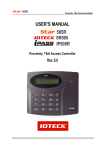
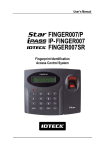


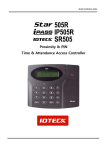
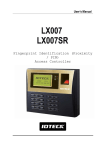
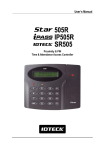
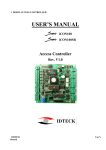


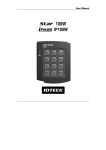
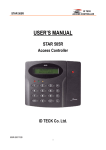

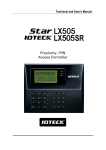
![Intelligent Multi Door [4] Access Control Panel](http://vs1.manualzilla.com/store/data/005798503_1-5afef044e5faf65af74eeb67e2f6e9c7-150x150.png)
